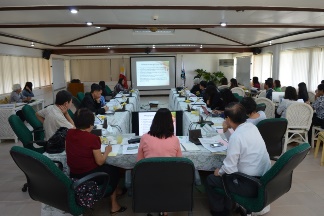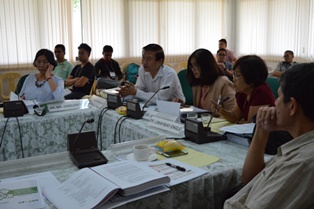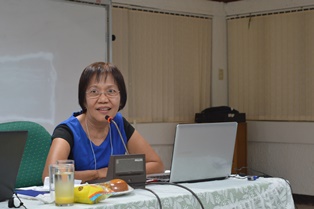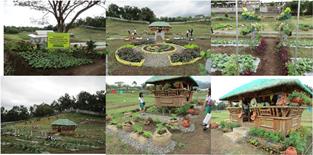LOS BAÑOS, Laguna--The Vegetable Research and Development Review and Planning was conducted here recently.
Spearheaded by the Philippine Council for Agriculture, Aquatic and Natural Resources Research and Development of the Department of Science and Technology (DOST-PCAARRD), the activity paved the way for the evaluation of accomplishments, assessment of technologies, identification of gaps, and showcasing of innovative technologies that can help boost the Philippine Vegetable Industry.
Speaking on the importance of the event, Ms. Leilani Pelegrina, Vegetable Industry Strategic S&T Program (ISP) Manager, from the Crops Research Division (CRD), PCAARRD, said that the meeting would help determine which activities were more important and urgent to effect the wise use of resources.
 Among the technologies featured during the meeting were:
Among the technologies featured during the meeting were:
1. Phytochemical coating, which was found to extend the shelf-life of vegetables─The coating made from hagimit (Ficus minahassae) prolonged the freshness of tomatoes from 27 to 83 days, a difference of almost two months.
2. Dipping pechay in 1% vinegar solution for two minutes before rinsing─The technology significantly reduced insecticide residues. Other effective methods included use of liquid detergent, boiling, and grilling. The common household practice of washing vegetables with running water failed to lessen insecticide residues in vegetables as shown in a study.
3. Rapid Bioassay for Pesticide Residues (RBPR)─This is a tool that can quickly detect traces of organophosphates and carbamates pesticides in vegetables during pre- and postharvest. RBPR can aid in pesticide regulation programs for agencies such as the Fertilizer and Pesticide Authority, Bureau of Agriculture and Fisheries Standards, Food Development Center, and Organic Certification Center of the Philippines. This technology is currently being pilot-tested in Laguna, Quezon, and Benguet.

 4. Biological control agents (BCAs) against bean rust, powdery mildew in tomato, anthracnose, and alternaria leaf spot in Chinese cabbage─BCA are natural enemies of particular pests that are used as part of pest management. IEC materials on these biocon technologies were already published through the project.
4. Biological control agents (BCAs) against bean rust, powdery mildew in tomato, anthracnose, and alternaria leaf spot in Chinese cabbage─BCA are natural enemies of particular pests that are used as part of pest management. IEC materials on these biocon technologies were already published through the project.
Exciting opportunities have sprung from the findings of these projects. For one, the optimized grafting technologies for year-round vegetable production are now apt for commercialization. These grafted seedlings at the Bureau of Plant Industry-Los Baños National Crop Research, Development and Production Support Center (BPI-LBNCRDPSC) range from ₱5 to 8 per seedling for solanaceous, and ₱10 to 12 per seedling for cucurbits.
The Review and Planning also showed that Phase 2 of the project, “Targeting Induced Local Lesions in Genome (TILLING) of Tomato for Multiple Virus Resistance” is on its way. The project will focus on the molecular marker-aided breeding for outstanding fresh, salad, and processing tomato.
The Technology Demonstration project, which is also being implemented by BPI-LBNCRDPSC was presented during the meeting. The project includes landscaped vegetable gardens and a park designed for learning and income generation. It houses four technologies under the organic production system and ten cultural management technologies under the conventional production system.
 Thirteen ongoing and completed DOST-PCAARRD R&D Projects on vegetables were presented by implementers from the University of the Philippines Los Baños (UPLB), BPI- LBNCRDPSC, Benguet State University (BSU), Visayas State University (VSU), and Industrial Technology Development Institute (ITDI) to a panel of evaluators and experts from DOST-PCAARRD, UPLB, Philippine Sugar Research Institute (PhilSURIN), Central Luzon State University (CLSU), and Harbest Agribusiness Corporation. Forty-seven participants engaged in the discussion.
Thirteen ongoing and completed DOST-PCAARRD R&D Projects on vegetables were presented by implementers from the University of the Philippines Los Baños (UPLB), BPI- LBNCRDPSC, Benguet State University (BSU), Visayas State University (VSU), and Industrial Technology Development Institute (ITDI) to a panel of evaluators and experts from DOST-PCAARRD, UPLB, Philippine Sugar Research Institute (PhilSURIN), Central Luzon State University (CLSU), and Harbest Agribusiness Corporation. Forty-seven participants engaged in the discussion.
Dr. Jocelyn Eusebio, Director of the DOST-PCAARRD Crops Research Division, challenged the team to make their technologies truly beneficial to the Filipino farmers, particularly in increasing yields and profits by reducing pests and diseases, trimming down postharvest losses, lowering production cost, and ensuring food safety, which are the major concerns in the vegetable industry.
